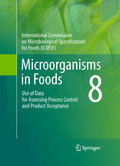
Microorganisms in foods 8: use of data for assessing process control and product acceptance
Microorganisms in Foods 8: Use of Data for Assessing Process Control and Product Acceptance is written by the International Commission on Microbiological Specifications for Foods with assistance from a limited number of consultants. The purpose of this book is to provide guidance on appropriate testing of foodprocessing environments, processing lines, and finished product to enhance the safety and microbiological quality of the food supply. Microorganisms in Foods 8 consists of two parts. Part I, Principles of Using Data in Microbial Control, builds on the principles of Microorganisms in Foods 7: Microbiological Testing in Food Safety Management (2002), which illustrates how HACCP and Good Hygienic Practices (GHP) provide greater assurance of safety than microbiological testing, but also identifies circumstances where microbiological testing may play a useful role. Part II, Specific Applications to Commodities, provides practical examples of criteria and other tests and is an updated and expanded version of Part II of Microorganisms in Foods 2: Sampling for Microbiological Analysis: Principles and Specific Applications (2nd ed. 1986). Part II also builds on the 2nd edition of Microorganisms in Foods 6: Microbial Ecology of Food Commodities (2005) by identifying appropriate tests to evaluation the effectiveness of controls. Contains wealth of information on food microbiology and food safety. Provides guidance on the appropriate testing of food processing environments. Presents ways to improve the microbiological safety of food. INDICE: Preface. Contributors and Reviewers. Abbreviations Used in the Book. Part I. Principles of Using Data in Microbial Control. 1. Utility of Microbial Testing for Safety and Quality. 2. Validation of Control Measures. 3. Verification of Process Control. 4. Verification of Environmental Control. 5. Corrective Actions to Re-Establish Control. 6. Microbiological Testing in Customer-Supplier Relations. Part II. Applications of Principles to Product Categories. 7. Applications and Use of Criteria and Other Tests. 8. Meat Products. 9 Poultry Products. 10. Fish and Seafood Products. 11. Feeds and Pet Food. 12. Vegetablesáand Vegetable Products. 13. Fruits and Fruit Products. 14. Spice, Dry Soups and Asian Flavorings. Cereals and Cereal Products. 16. Nuts, Oilseeds, Dried Legumes and Coffee. 17. Cocoa, Chocolate and Confectionary. 18. Oil- and Fat-based Foods. 19. Sugar, Syrups and Honey. 20. Non-Alcoholic Beverages. 21. Water. 22. Eggs and Egg Products. 23. Milk and Dairy Products. 24. Shelf-TableHeat Treated Foods. 25. Dry Foods for Infants and Young Children. 26. Combination Foods. Appendix 1. Sampling Considerations and Statistical Aspects of Sampling Plans. Appendix 2. Calculations for Chapter 2. Appendix 3. ISO Methods Referenced in Tables. Appendix 4. Objectives and Accomplishments of the ICMSF. Appendix 5. ICMSF Participants. Appendix 6. ICMSF Publications. Appendix 7. Sponsors of ICMSF Activities.
- ISBN: 978-1-4419-9373-1
- Editorial: Springer US
- Encuadernacion: Cartoné
- Páginas: 521
- Fecha Publicación: 17/04/2011
- Nº Volúmenes: 1
- Idioma: Inglés
